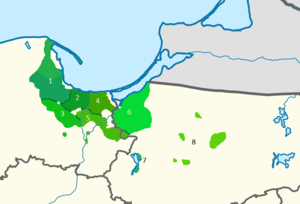Verse:Pamarija
Pamaria (or Pamarija in Pomorian, Pomorze Wschodnie in Polish, Pomerellen in German) is a northern Polish region on the southern shore of the Baltic Sea. It's name - Pamaria - comes from "pa marjau" ("by the sea" in Pomorian).
Geography
Pamaria is situated in the Baltic Depression (the Baltic lowlands) with only 50 to 100 meters above the sea level. It is the land of small lakes and swamps surrounded by large forests. However there are also many meadows and fields especially in the recent years with the development of agriculture in the region and the beginning of deforestation. A characteristic feature of the region is numerous small rivers and streams but only one navigable river - Viestla (Wisła in Polish). The main cities are Gudonuke (Gdańsk), Gudonia (Gdynia) and Sapati (Sopot).
Ethnicity
Nowadays a great majority of people living in Pamaria region are Polish (approximately 94-99%). The ammount of inhabitants who declares Pomorian as their nationality is very low - 4-6% in a small area in the west and 2-3% in the rest territory. Kashubians are also present, almost exclusively in the north-west (0.5-1%). In the south-eastern territories where Pomorians originated from almost all the inhabitants are Polish nowadays. This is the result of continuous wars with Germans and Poles, internal conflicts and variuos plagues during the Middle Ages and in the XXth century. During their later history Pomorian people suffered discrimination and repression and were always associated with poverty and poor education. They were also challenged by Christian missionaries during the Middle Ages for being pagans. The process of assimilation had most impact on the children who wanted a better life and felt asshamed of their people because of stereotypes. Soon the old Pomorian traditions became almost completely forgotten remaining only in distant villages which were cut from the rest of the world due to absence of any means of communication at that time.
A lot of Pomorians do not want to recognise this name as their nationality. Usually Western Pomorians call themselves pumurėnė (/pu.mu.ˈreː.neː/) and other groups - vysilionė/vyslionė (/ʋiː.ɕi.ˈʎoː.neː/). Central Pomorians are pamarė (/pa.ˈmaː.rʲeː/) but sometimes also viestlionė because they mostly live near the Vistula river. Eastern Pomorians are suvylki (/su.ˈwɨl.ki/) after the land they inhabit and South-Eastern are ezerovė (/ɛ.zɛ.ˈroː.veː/) after the word ezerå which means "lake". They even use different orthographies for Western and Eastern dialects which are sometimes considered being different languages and these dialects have a low mutual intelligibility between each other which only sharpen the differences.
Language
Throughout its history Pamaria was inhabitted by different ethnic groups and many languages were spoken there with main one being German. After the World War II a number of German native speakers decreased significantly within just a decade. Nowadays the most commonly spoken language is Polish (80-99%), at least 5 to 10% of people in the area are able to speak Pomorian on a basic level but only 4000 people speak Pomorian natively or most of the time, almost all being at the age of 50 or above. Despite current revitalization efforts most Pomorian children do not speak Pomorian at all or know some basic words/can say few sentences in it.
